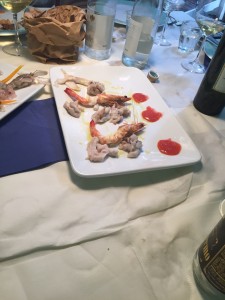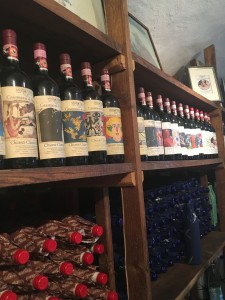How Technique Creates Art in Foos
June 16th, 2016 by cmconn18
Introduction
Food is a very complex entity, that can take years to come to fully understand. Starting from where foods are grown and following the process all the way to when it is eaten at a table, it becomes clear that food is more than just a combination of ingredients. The notion of food is embodied in the way in which the ingredients are combined and that is what constructs the more confusing, and fascinating part of food. Some people seem to have a natural skill at being able to produce some delicious masterpiece, while other struggle to boil some pasta. A special technique is obviously required in order to truly master the proper manipulation of food in a way that is both appetizing and aesthetically pleasing. In this paper I will exam the role the that technique plays in establishing food as an art form.
Argument Against Food as Art—Telfer
In “Food for Thought-Philosophy and Food” by Elizabeth Telfer, the author argues that food cannot be a major art form. She does this by outlining three characteristics of food that limit it to only being a simple art form. First, she says that food is simple; however, the next wo points that food is transient and lacks the ability to express emotion are the two arguments that she focuses on. When Telfer describes food as transient, she explains that it is not meant to last for long amount of time. Next, when Telfer says that food cannot express emotion, she explains that art is meant to withdraw intense feelings from the viewer—Telfer states that food cannot do this. Furthermore, Telfer argues that cooking is more of a craft than an art form because of the functionality. She states “it is inappropriate to look at food aesthetically because this is treating a means as an end, and assuming food to be positively good when it is merely necessary” (Telfer, 1996). Telfer believes that because we need food, and use it as a way of satisfying a need, it cannot be appreciated as a major art form. Continually, our tastes influence our perception of the art, while sight and hearing are considered the nobler senses in terms of appreciating art—as such art that requires taste instead of just sight or hearing is inferior. I however believe that all of these arguments can be contradicted when the technique of cooking is examined from a both critical and aesthetic standpoint.
Lunch at Buonumore
While in Viareggio, we had lunch at a “slow food” restaurant called Buonomore that specialized in fish and other types of seafood. The “slow food” motto reflects the restaurant and cook’s philosophy that we need to take a step back from our fast lives and sit down and enjoy a meal with the people around us, both in terms of how we consume the food and that pace at which the meal is presented to us. Each course had some type of fish in it, and was presented to us one at a time with a lot of time in between so that we had ample time to enjoy each dish and not rush through the meal. The dishes were brought to us artfully arranged on plates that inspired many food Instagram photos to be taken.


After the meal was over, the head chef came over to our table and explained some of his methods and beliefs when it comes to preparing these foods. The cook, Amelio, explained that each food had to be treated individually, and different genetic makeup of each fish had to be respected when cooking it. He firmly believes that when cooking you do not need to add a lot of extra ingredients or flavors because if you cook it the right way, you should be able to get all the natural nutrients and flavors from that particular food. For example, while most of his food tasted salty (in a way that only complimented that flavors of this fish) he added little to no salt, but just cooked it in a way that was able to bring out that salt that is in the fish. The same technique is applied to the nutrition aspects of the food; it is imperative to understand the chemistry of the food because if something is overcooked or undercooked the nutrients could either be boiled off or not brought out enough in the food. Amelio believes that cooking is less about the artistry of the action, but that one must understand the technical aspects that go into each dish in order to create something delicious, and it is in the mastery of the technique that art can be found.
How Food becomes an Art
In response to Telfer, Amelio would argue that it is in understanding the process and appreciating the technique that brings out the emotion behind food. While he does not necessarily consider himself an artist, Amelio’s ability to master a skill that others find desirable and is not easily done by others makes his craft valuable and an art form. Furthermore, in contrast with Telfer’s argument stating that because something is a means to an end it cannot be an art, Amelio’s overall presentation of each dish shows an appreciation for the aesthetic beauty in cooking. Incessantly, the beauty can be in how each dish is prepared at a temperature specific to that animals anatomy, and only natural ingredients were used to highlight each fish’s unique flavors. The skill of being able to understand the food and how to manipulate it can be compared to understanding paints and learning how to mix colors and different kinds of paint to create a masterpiece: both true forms of art, simply expressed in different medias.
Chiccheria Gelateria
Another place that really focuses on the technical aspect behind preparing food is the gelato place in Grosseto called Chiccheria Gelateria. Manuele Presenti, the owner and founder of this particular Gelateria studied chemistry very closely and now focuses on how to properly combine ingredients to get the best result. A prime example of this is the difference between a sorbet and granita. Both have the same list of ingredients; however, the way in which they are combined creates two distinctive different textures and tastes. Manuele is another case of a person who has turned his craft into artisanship because he has taken a knowledge of the materials that he works with and has managed to manipulate them in ways that are pleasing to his audiences—something that other producers in his field have fallen short of when they attempt a similar feat.
Conclusion
Overall, while the argument on what Telfer constitutes as art holds true, what does not align are her assumptions about the role food plays. Through the passing down of techniques of cooking and how to properly prepare dishes food and cooking is an art that can becoming long lasting and enjoyed multiple times. Moreover, it is this very technique of cooking, that can only be accomplished through the painstaking study of food and its properties that one can feel the emotion that each flavor, bite, and dish possess. It is for these reasons, that cooking is so much more than just a craft, the mastery of good cooking where there is an understanding and respect between the cook and the ingredients is just as much an art as putting paint on a canvas or carving a sculpture out of clay.
Works Cited
Telfer, E. (1996). Food for thought: Philosophy and food. London: Routledge.

